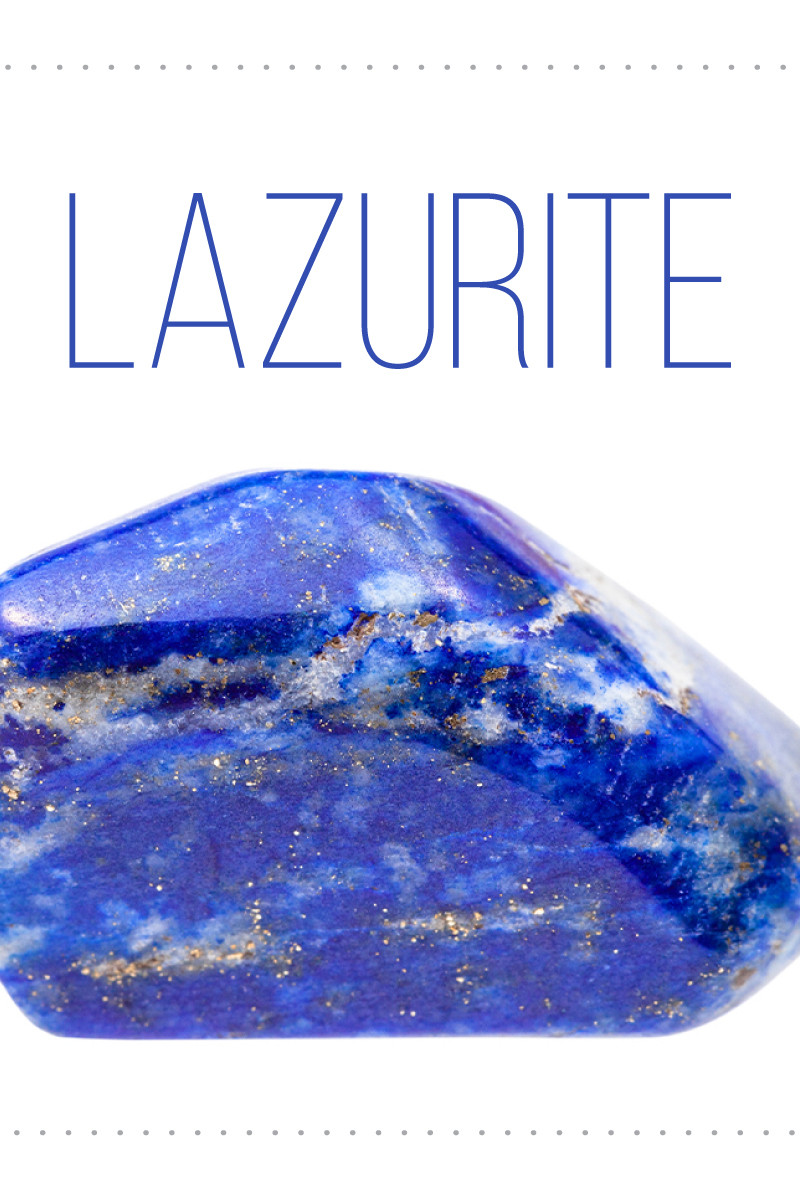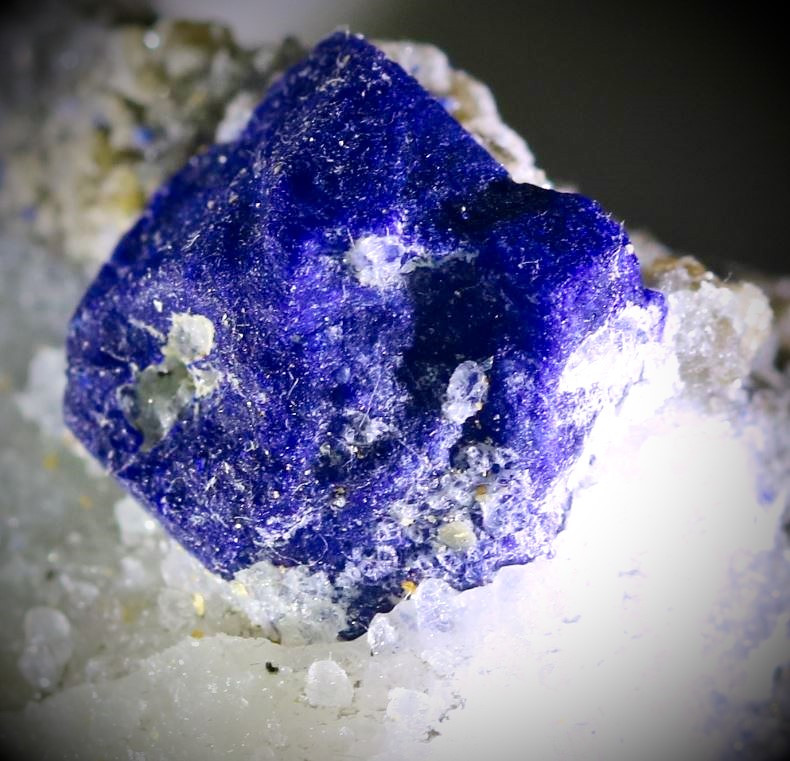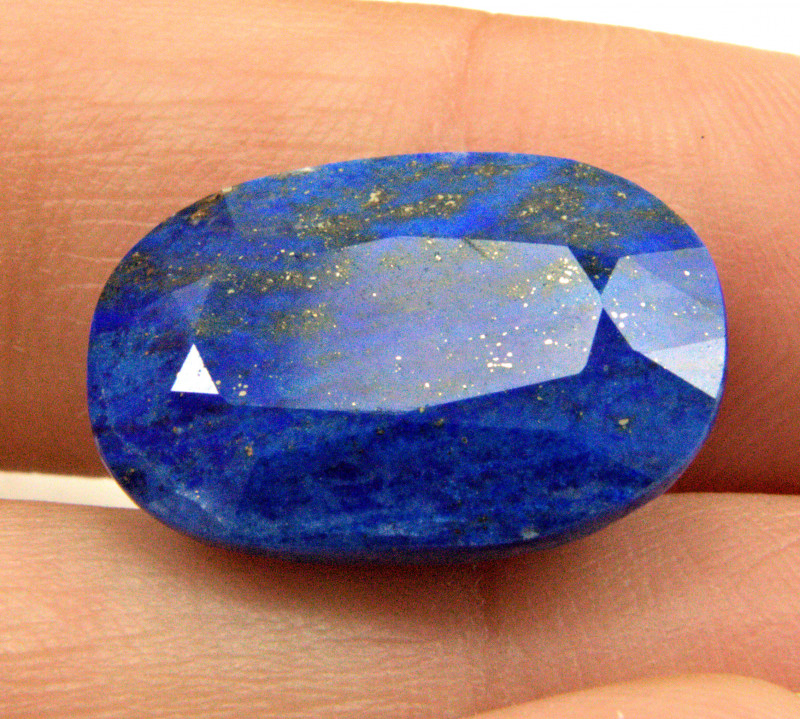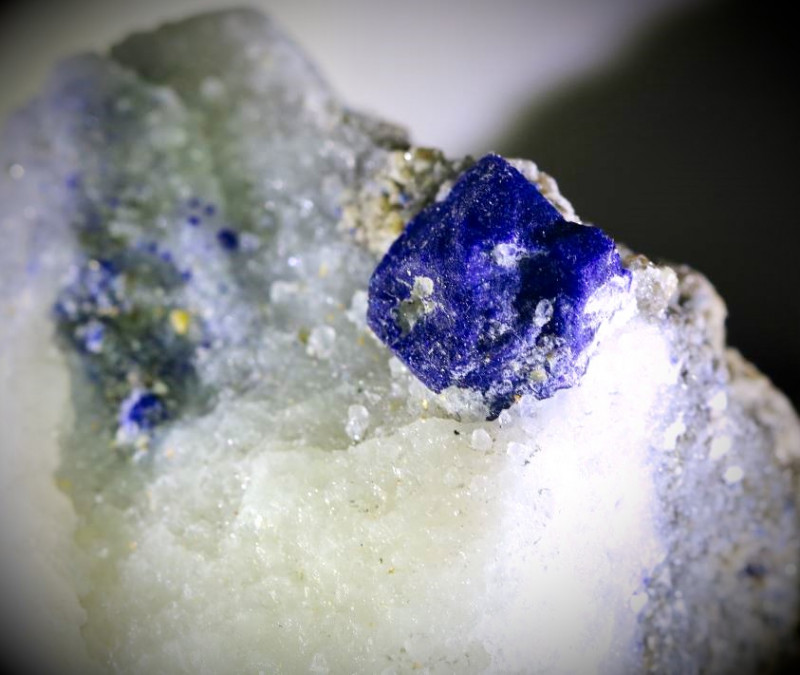
Lazurite Gemstone: Properties, Meaning, Uses, and More!
 Lazurite is a dreamy gemstone that comes in deep blue shades, often contrasted against the cool, gray background of the limestone cracks from which they formed.
Lazurite is a dreamy gemstone that comes in deep blue shades, often contrasted against the cool, gray background of the limestone cracks from which they formed.
While the lighter blue shades seen in gemstones like azurite have a cheerful, bouncy appeal, the deep lazurite blue evokes feelings of intrigue and intensity. You might think of the cold yet fabulous style of a calm and collected ice queen.
Or, if you close your eyes, you might envision the color of the scary yet striking cracks that form along an Arctic ice bed, with the abyss of the ocean peeking through.
Lucky for us, lazurite is more than just a pretty blue gemstone. Lazurite is one of the main ingredients in another gemstone we all love: lapis lazuli! But is lazurite the same as lapis lazuli? Not quite!
Today, we’ll cover everything you’re wondering about the lazurite stone, including lazurite uses, properties, and similarities with other blue gemstones.
First, let’s start with the basics of what lazurite means, including the lazurite spiritual meaning.

What is Lazurite Stone?
Lazurite is a calcium aluminum silicate crystal that forms along the cracks of smooth, gray limestone. You might also find it in large pieces of marble, displaying a striking blue-white contrast.
The word “lazurite” stems from the Farci word lazwad, which means blue. An Arabic root also connects lazurite’s meaning to the word heaven — not surprising given its divine beauty!
Spiritually, lazurite is known to expand your awareness, giving it spiritual connotations of divine connection, harmony with nature, and honesty in action and communication.
Lazurite’s spiritual benefits are especially potent for those born around the holidays, as the stone is a great alternative December birthstone or a zodiac stone for Sagittarius and Capricorn!
Mineral Characteristics
Lazurite stone is a mineral containing sodium, calcium, aluminum, chloride, and sulfur. Lazurite also contains trace amounts of sodalite and hauynite molecules. In fact, its unique, ultramarine-blue color is a direct result of an electric charge between sulfur atoms!
The stone ranks a modest 5-5.5 on the Mohs mineral hardness scale, meaning it can beat up its light blue friend azurite (3.5-4) but wouldn’t stand a chance against the robust diamond or emerald (8-10).
While gemstone hardness is an important buying factor, lazurite has other features that overshadow its softness and make it deserving of a slot in your gem collection.
Lazurite and Other Blue Gemstones
Lazurite, lazulite, sodalite, azurite, lapis lazuli — what’s the difference? Lazurite is often confused with these blue gemstones, but we’re going to clear that up.
Is Lazurite the Same as Lapis Lazuli?
 (image: lapis lazuli)
(image: lapis lazuli)
Lapis lazuli is a semi-precious gemstone known as the true gemstone version of lazurite. It’s made from lazurite, pyrite, and calcite, along with other minerals like diopside, sodalite, and mica. However, keep in mind that not all of these minerals are always present within a lapis lazuli stone. So, lazurite is a key component of lapis lazuli, though the two are distinct stones.
Lazulite vs. Lazurite
 (image: lazulite | Credit: Photograph by Andrew Silver)
(image: lazulite | Credit: Photograph by Andrew Silver)
How about lazulite vs. lazurite? A crystal with similar etymological origins to lazurite, lazulite comes from the German word lazurstein, which means “blue stone.” But lazulite comes in different shades of blue, namely light sky blue or dark navy tones - it’s as though lazulite skipped lazurite’s ultramarine blue on the color scale. Lazulite is also transparent, while lazurite is usually opaque.
Lazurite and Azurite
 (image: azurite)
(image: azurite)
What is the difference between lazurite and azurite? Both are predominantly opaque, blue gemstones and known to awaken our psychic abilities by stimulating the third-eye chakra!
But the similarities end there. Azurite has a monoclinic crystal structure, while lazurite is isometric. Azurite also has a conchoidal fracture, meaning it breaks without any structure or pattern. The most significant aesthetic difference, though, is the color. While both stones are blue, azurite is a light, turquoise to sky blue, reminiscent of an icy skating rink, while lazurite’s deep ultramarine blue resembles a vast sea.
Lazurite and Sodalite
 (image: sodalite)
(image: sodalite)
Don’t worry; this is the last similar gemstone we’ll cover before moving onto the juicy lazurite healing properties!
So, what is the difference between sodalite and lazurite?
While both are blue, opaque, and often vitreous gemstones, sodalite has a cloudier look because its body is often mixed with blue and other tones like gray or white. You can even find sodalite in deep purple tones, with small cabochon cuts resembling plump, violet grapes. However, it’s important to note that technically, lazurite is part of the sodalite mineral group.
Alright, enough about other gemstones — this is lazurite’s time to shine! Let’s look at lazurite’s specifications and characteristics.
Lazurite Specifications and Characteristics
Color: Deep, ultramarine blue, sometimes has greenish or violet tones
Crystal structure: Isometric
Luster: Vitreous or greasy but can sometimes be dull
Transparency: Usually opaque, but sometimes translucent
Refractive index: 1.50-1.52
Density: 2.38 - 2.45
Cleavage: Imperfect/Fair
Fracture: Subconchoidal
Streak: Blue
Luminescence: Usually non-fluorescent, but sometimes orange-brown

Lazurite Healing Properties
If you find a lovely lazurite specimen to display on your entry table, you’re in for quite the treat. Not only will your new décor spark conversation, but lazurite properties also include some awesome health benefits.
There’s a reason why Ancient Egyptian royalty adorned themselves with lazurite jewelry over 6,000 years ago. Apart from its beauty, what is lazurite used for?
Let’s start with purported lazurite stone benefits for our physical health.
Physical Healing
Blue lazurite meaning includes feelings of calmness and tranquility, similar to the steady waves of the ocean. It’s only natural that this healing stone’s physical healing properties should include soothing pains, including headaches, joint pain, and muscle aches. Headaches are also a symptom of an unaligned third-eye chakra, but we’ll get into chakras later.
Other purported health benefits include treating respiratory ailments like asthma and bronchitis; however, you might also use it to manage the breathless feeling brought on by stress.
How about lazurites’ emotional benefits? Let’s find out!
Emotional Healing
You might wonder, then what is lazurite good for emotionally? Lazurite is mainly used to balance the chakras in crystal healing.
We could reasonably infer that lazurite has similar emotional healing properties as its parent gemstone, lapis lazuli. Known as the “crystal of truth,” lapis lazuli helps you release buried emotions and express yourself without masking your desires and character.
Sometimes we keep unwanted emotions buried deep down to protect ourselves, but they stir up more harm buried than when they’re released. Lapis lazuli and lazurite help you face repressed emotions and feelings of anger so that you can let them go and vibe higher.
Lazurite Chakra Healing
The chakras host our body’s pulsing energy centers, rich with metaphysically colored auras that correspond to each major area of the body. Many crystals are known to activate, align, and open our chakras to promote better health.
Lazurite metaphysical properties work wonders for one chakra that Frida Kahlo connected with. Lazurite links to the third-eye chakra, helping us hone in on our intuitive power and, for some, clairvoyance, according to some crystal healers. Our third-eye chakra falls between our eyebrows; a spiritual chakra, it’s known to rule our intuition and connection with a higher being.
While we can’t promise that lazurite will help you read minds, we still invite you to hold onto it for a while and meditate on the energy you feel around your third eye. Take a moment to reflect on your past, present, and who you are in this world – your third eye might vibrate with insight if you have some lazurite around!
Lazurite is thought to promote self-awareness, a sign of an opened third-eye chakra! That self-awareness trickles into other positive effects, like a stronger memory, authentic conversations, and greater fulfillment in life.
Curious about lazurite’s physical properties? Read on to learn more about how lazurite’s clarity, cut, and color make these stones shine and sparkle with beauty.

Lazurite Gemstone Properties
Gemstone sellers and experts assess stone values by looking at gemstone properties, like color, cut, and clarity. Let’s take a look at how those three properties appear in the lazurite stone.
Color
What color is lazurite? By now, you’ve surely gathered that it's blue. But it’s not exclusively blue or just any shade of blue, either.
Lazurite crystal is a striking ultramarine blue with tones as dark as the Black Sea. The depth of color makes it hypnotizing to anyone that casts their eyes on it! You might also see some lazurite with tones of green and purple, but deep ocean blue is most common.
Opaque blue lazurite isn’t known to have any fluorescence. However, translucent varieties, especially those with green tints, sometimes have orange-brown fluorescence.
Cut
Lapidaries (gem cutters) tend to have a lot of fun with lazurite because we see it fashioned into so many different cuts! The job isn’t easy, though, since lazurite’s poor cleavage makes cutting a difficult task. Nevertheless, we still see many lazurite cuts, from cabochons to faceted gemstones.
Smooth cabochon cuts are common. So are rounded beads that look especially striking for midnight blue stones — the color and shape of beaded lazurite are reminiscent of the deep blue planets Neptune and Uranus.
You might also see some faceted cuts that do a great job of highlighting the fluorescence of the more greenish lazurite varieties. But for opaque gems, faceted cuts aren’t as common.
Clarity
Clarity refers to a gem’s transparency or lack of, with each gem ranging from a scale of transparent to opaque. Lazurite is almost always opaque, boasting deep midnight blue tones all around.
Inclusions usually lower a gemstone’s value, and that’s also true for lazurite. Sometimes you’ll see white calcite speckles within a lazurite stone, or gold pyrite inclusions. However, this isn’t always the case. Many gemstones, including agate and star sapphires, gain value from their novel inclusions that evoke vivid patterns and colors. Personally, we find the golden pyrite inclusions quite charming!

Lazurite Origins and Sources
Lazurite shares a similar chemical formula to the mineral hauyne, though it replaces sulfate with sulfide. Funny enough, much of the lazurite on the market has sulphate, which really makes it a hauyne rock instead of a lazurite stone. But for gem experts, the difference is miniscule and they still view the two stones similarly.
Lazurite Mining Locations
Lazurite is a relatively rare mineral, making it a higher-priced gemstone than many other similar-looking stones. Despite its rarity, you can find it in quite a few places around the world, including:
Sar-e-Sang, Badakhshan Province, Afghanistan
Slyudyanka and Bystraya Rivers, Sayan Mountains in Siberia, Russia
Pamir Mountains, Tajikistan
Alban Hills in Lazio, and Monte Somma in Campania, both in Italy
Ontario Peak and Cascade Canyon in San Bernardino, California, US
North Italian Mountain, Colorado
Baffin Island, Northwest Territories, Canada
Mogok, Myanmar
Ovalle, Chile
Where is lazurite most commonly found? Primarily Afghanistan, where the stone was discovered over 6,000 years ago. Afghanistan boasts some of the most expensive and impressive-looking specimens. While most raw lazurite is found in massive form, Afghanistan is the home of gorgeous blue-rich lazurite crystals.
Afghanistan’s striking blue lazurite crystals latch onto large, white marble matrices with confidence.
These are often sold as-is, making incredible décor pieces, and sometimes sliced into slabs, displaying even more beauty on the inside.

Lazurite Stone, Price and Value
Overall, the average lazurite stone price reflects the gem’s rarity. So, what is lazurite worth?
It’s not uncommon to see an opaque lazurite ring go for at least $100, if not more. We also tend to see near-opaque, deep blue lazurite jewelry with gold-colored inclusions selling for the same price, despite the general rule that inclusions lower value. This beautifully demonstrates how inclusions can add value to a gemstone if they are a particularly beautiful color or pattern.
Lapis lazuli, whose main ingredient is lazurite, ranges between $100-$150 per carat. You can also find raw lazurite still attached to limestone at the $100-$200 range as well.
Now that you know the high lazurite price for raw stones and jewelry, it’s time you learn how to take care of your investment!
Lazurite Care and Maintenance
With a relatively low Mohs ranking, lazurite is rather delicate. When wearing lazurite jewelry, stick to this rule: take it off first and put it on last. Take care not to let it tangle into your makeup routine or hair styling. It’s best to keep lazurite away from any chemical cleaners and other jewelry pieces to limit the chance of scratches. If you can’t keep it in a separate drawer, store lazurite stones in a soft velvet pouch.
Additionally, try not to do anything strenuous or adventurous while wearing lazurite. This isn’t the type of stone that can bear strong impact from exercise or strenuous physical activity. The last thing you want is your precious lazurite to crack, and your heart along with it!
For cleaning, we recommend wiping it down with a soft cloth to remove any oils from your skin or skin care routine.
Add Pizazz with Lazurite Gemstones!
Lazurite is a magical stone that encapsulates the mystery of the sea’s abyss and pairs it with the peaceful charm of an innocent blue starling.
A statement piece in every way, lazurite will remind you of the calming, pure lazurite crystal meaning every time you glance at your blue cabochon ring or the massive crystal specimen on your dining table.
Ready to add pizazz with lazurite? Shop lazurite gemstones today!
Search the Gemstone Encyclopedia
Related Auctions
Related Articles
Azotic treatment of Topaz and Quartz is a treatment that creates a layer of color over a gemstone. Learn more about this treatment and check out our stones fro sale.
8th May 2018
Quartz and Topaz are two of the most common minerals on the planet. They also look very similar. Let's look at some properties of them and compare Quartz and Topaz.
23rd Oct 2018
Gemstones and crystals are capable of absorbing and conveying energy, that’s why it’s important to cleanse, re-charge and program your stones so that they may achieve their best potential.
9th May 2018
Latest Articles
Yugawaralite is a rare colorless, white, or pinkish zeolite crystal named for its discovery in Yugawara, Japan. Here we uncover the multifaceted history, properties, prices, and uses of yugawaralite.
24th Mar 2025
Simpsonite is a lesser-known mineral known on the gem market for its durability, yellow-orange color, and rarity. Discover all the properties, uses, prices, and history of simpsonite.
3rd Mar 2025
Kurnakovite is a colorless crystal related to inderite and rarely faceted but known among collectors. Explore the mineral traits, history, prices, and more in this kurnakovite guide.
17th Feb 2025
Article Categories
How To's is where you will find helpful articles from gem Rock Auctions on how to cut gemstones, select gemstones and buy gemstones.
9 Articles





